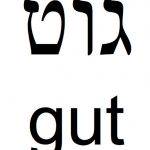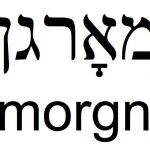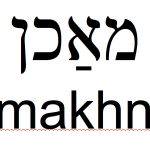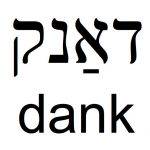GUT MORGN!
VOS MAKHSTU?
GUT. A DANK!
ZI KUMT MORGN.
GUT = גוט = BON = GOOD
GUT MORGN! = !גוט מאָרגן = BONJOUR! = HELLO!
MORGN = מאָרגן = DEMAIN = TO-MORROW
MAKHN = מאַכן = FAIRE = TO DO, TO MAKE
A DANK = אַ דאַנק = MERCI = THANK YOU
Vous avez remarqué?
Dans l’expression, GUT MORGN concerne aujourd’hui alors que MORGN signifie demain. En fait MORGN a aussi le sens de “matin”, mais GUT MORGN se dit toute la journée pour se saluer.
MAKHN signifie faire mais l’expression idiomatique VOS MAKHSTU signifie “comment ça va?” Un peu comme “How do you do?” en anglais. C’est plus une formule de politesse qu’une invitation à parler de tous ses soucis. ![]() 🙂
🙂
Attention, en yiddish, il faut dire A DANK et non DANK et encore moins “Danke” comme en allemand! En yiddish, DANK est un nom complément d’objet d’un verbe sous-entendu alors qu’en allemand “Danke” est un verbe et c’est le pronom personnel de la première personne qui est sous-entendu. Un exemple parmi mille qui montre que, tout en puisant dans un fonds lexical commun, ce sont bien deux langues qui “pensent” différemment.
Did you notice?
In the phrase, GUT MORGN is about today while MORGN means tomorrow. In fact MORGN also has the meaning of “morning”, but GUT MORGN is said all day to greet somebody.
MAKHN means doing but the idiomatic expression VOS MAKHSTU means “how are you?” Like “How do you do?” in English. It’s more of a courtesy than an invitation to talk about all your worries. ![]() 🙂
🙂
Beware, in Yiddish, we must say DANK and not DANK and even less “Danke” as in German! In Yiddish, DANK is a direct object of an implied verb whereas in German “Danke” is a verb and it is the personal pronoun in first person that is implied. An example among a thousand that shows that, while drawing from a common lexical basis, they are indeed two languages that “think” differently.
Apprenons à reconnaître la lettre ג (Gimel) qui correspond au son G(U).
Pour plus de précisions voir le post de Regine Bloch-Fiderer
Learn to recognize the letter ג (Gimel) that corresponds to the sound G (U).
For more information see Regine Bloch-Fiderer’s post
https://www.facebook.com/groups/YiddishPourLesNuls/permalink/489665397882510/
Ecoutez l’enregistrement audio ici/ Listen to the audio recording here
https://soundcloud.com/user-369999034/yiddish-lecon-17






